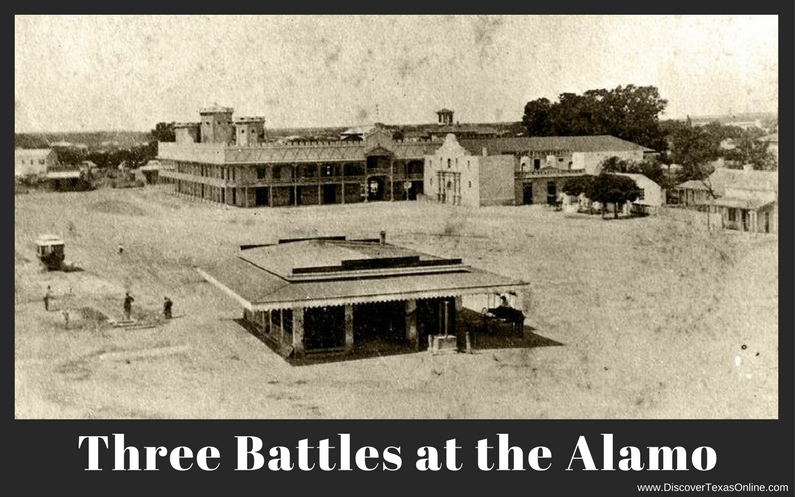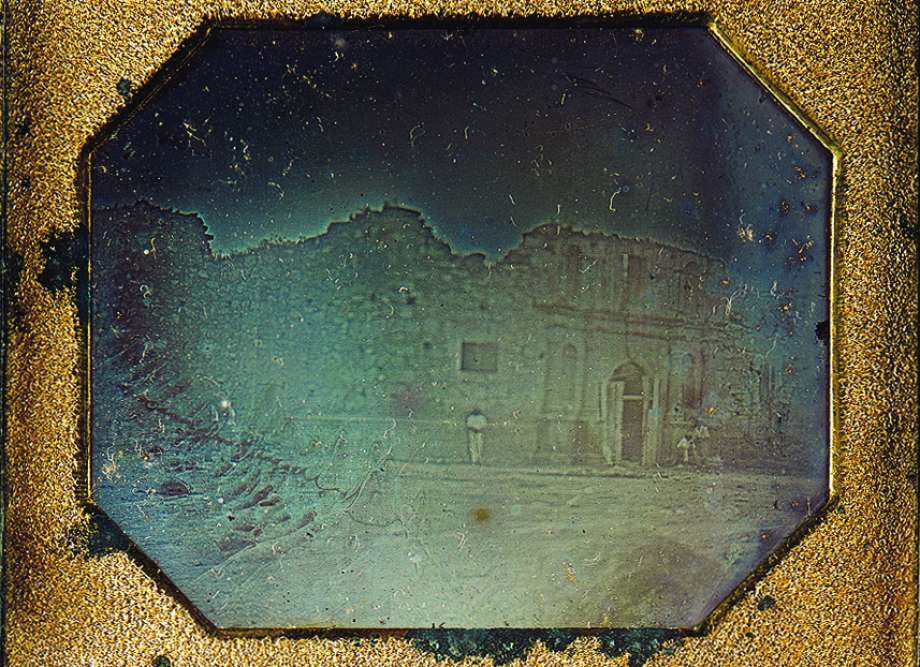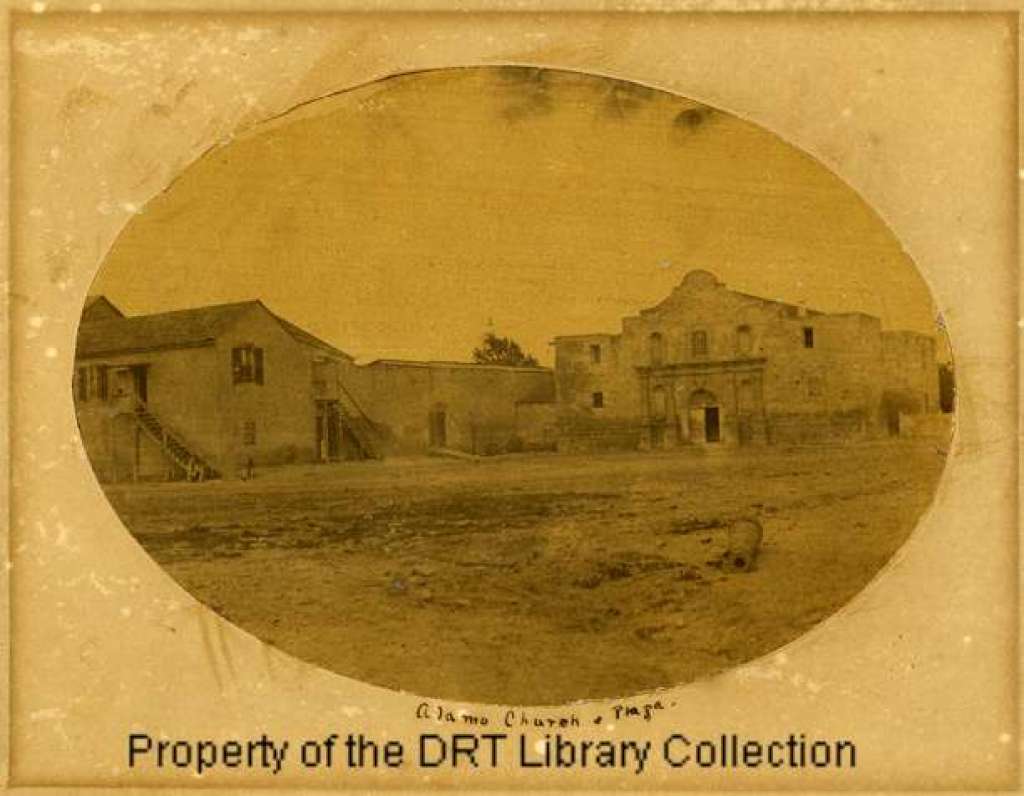 How much do YOU know about the Alamo’s past and the plans for its future?
How much do YOU know about the Alamo’s past and the plans for its future?
What Texans know as “the Alamo” was built as a mission church–San Antonio de Valero–in 1744. I say “built”, but actually the chapel was never finished. The Alamo had no roof until much later.
The Catholic church eventually gave up using San Antonio de Valero. Around 1803 the compound was secularized, which means that the church gave it to others for non-religious uses. The old church building was used as a military garrison, among other things.
In 1836, of course, the Alamo became the site of the famous siege that made possible an independent Republic of Texas.
Here’s what it looked like after the famous battle. This daguerreotype image was made in 1849–just 13 years after the Battle of the Alamo. You can see the damage to the walls. Can you see the broken chapel doors and how light shows through one of the upper windows where the roof is missing? Also notice that the front wall is square, not arched like today. That’s the way it was built.

Daguerreotype from the Dolph Briscoe Center for American History at the University of Texas at Austin
Here’s how the building looked nine years later in 1858. The US Army was using the chapel to store grain, and the Army Corp of Engineers made some much-needed repairs. They added the iconic arch when they repaired the roof sometime around 1850. You can see the open plaza in front of the chapel and the 2-story long barracks.

Daughters of the Republic of Texas Library Collection
The buildings were kept in fairly good repair while the Army was using them, but the Army outgrew the facilities in 1870 and moved on. By this time, the Alamo was over 100 years old and had seen a great deal of use and abuse. It began to crumble again.
Almost 50 years later, on October 30, 1885, the State of Texas purchased the Alamo chapel from the Catholic Church.
Though most Texans at the time would have known the story of the siege and fall, but there was no real reason to have visited. Tourism wasn’t really “a thing” then, and there wasn’t much to see, anyway.
Here’s how the Galveston News reported the purchase:
San Antonio, Tex., October 30, 1885 – The State of Texas now owns the Alamo, for the purchase of which the Eighteenth legislature appropriated the sum of $20,000. I have here before said that it is a monument to heroism as well as of a civilization, but there is little now remaining to indicate its ancient origin or use, for it no longer resembles a mission, nor the ruins of a mission, but it has rather the appearance of a stone warehouse – the towers and stone roof are gone and a plain tin or iron roof now covers the Alamo.
The front and rear walls above the upper windows have been rebuilt with stone, in the style of modern architecture, and taken altogether, it has an unsightly appearance, for a building so renowned. It would therefore be inappropriate to speak of it as a monument of ancient civilization, since there is nothing save the columns, front windows, and it may be the contour of the wall itself, that would suggest such an origin or use to the mind of the visitor.
As the people are supposed to have purchased the Alamo through the aforesaid legislature, it will not be uninteresting to them to learn its present condition; and as thousands of people, whose money is invested in it, may not have seen it, a minute description will no doubt be acceptable to them…
The article goes on to describe the physical features of the Alamo ruin in great detail, then says…
You pass around the walls which you see have been broken at the ends and a part of one side, and rebuilt with stone, half as thick as the original walls. You now descend to the first floor and enter a door in the north wing. Here the darkness is profound. Your guide lights a small lamp and you follow him through a narrow passage into the interior darkness.
You are informed that there are graves here, but you have not seen them – that heroes died here – and they may be there yet as far as you know. You feel oppressed and return by the narrow passage to the door by which you entered. You are now in the light – you have seen the Alamo. You pass out of the building disappointed, dissatisfied, disgusted. Did Texas heroes fall here? Can this be the monument purchased by the State to the memory of Bowie, of Crockett and of Travis?
You feel you have seen a warehouse instead of a monument. Indeed it was a warehouse from 1851 to the date of purchase by the State. The Eighteenth legislature called it a church, which is calculated to mislead the public mind. Did they not know the difference between a church and a warehouse? Once it was a church – later a warehouse.
Did they not think the people would like to see the property that had bought? If so, why did they not purchased the right of way around the Alamo?
Sounds like things were heating up for a skirmish! But this wasn’t the “2nd Battle of the Alamo.” Not yet. The “2nd Battle of the Alamo” took place from 1903-1912. That’s when Clara Driscoll, Adina de Zavala, and the Daughters of the Republic of Texas secured the ruins of the Alamo for $75,000 (quite a sum in those days!) and began to restore and preserve the site as a shrine. (The article at this link is really quite interesting. You should read it!)
In 2015–130 years after the Galveston News reporter got his knickers in such a twist–the state of Texas began to correct the oversight he mentioned about the right of way. That’s when the General Land Office announced that it had three buildings (the Woolworth Building at 518 E. Houston St., The Palace Building at 319 Alamo Plaza, and the Crockett building at 321 Alamo Plaza) on the west side of Alamo Plaza under contract. Red McCombs, a board member of the Alamo Endowment, said the goal is “to be certain that we come the nearest that we possibly can to re-creating the Alamo as it was at the time that that took place.”
If there’s one thing you can say about Texans, it’s that we do things in a big way! In this case, we seem to be gearing up to either spend big money or engage in a big fight over spending big money.
Either way, this is history in the making…or at least in the RE-making! Please take the opportunity to read up on the history of OUR Alamo, the work that’s been done to preserve it, the treasure it’s become, the plans that are proposed, and the objections to those plans. As always, it’s not my intention to tell you what you ought to think, but merely to invite you TO think about our past and how it shapes our future.
 How much do YOU know about the Alamo’s past and the plans for its future?
How much do YOU know about the Alamo’s past and the plans for its future?




